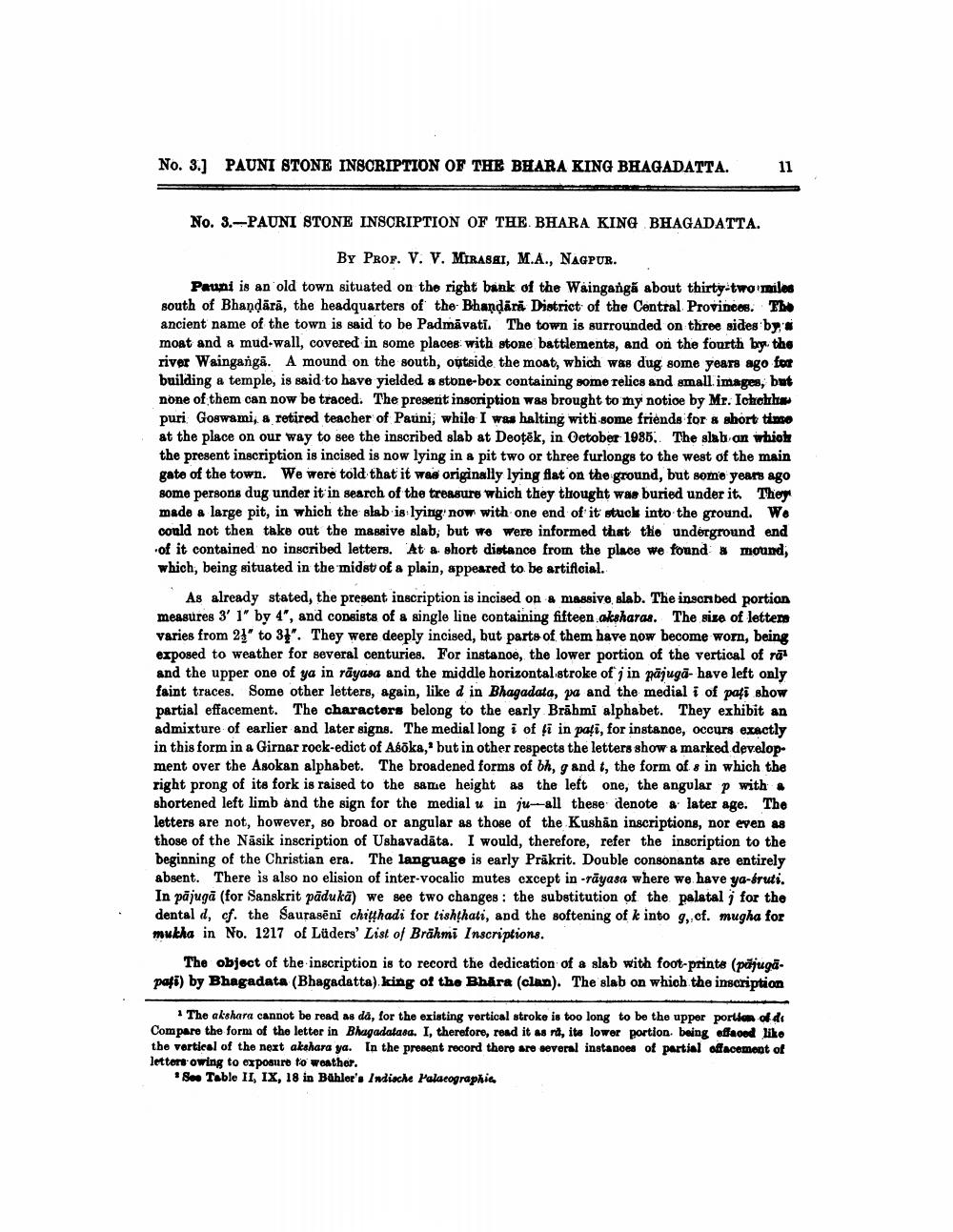________________
No. 3.] PAUNI STONE INSCRIPTION OF THE BHARA KING BHAGADATTA.
11
No. 3.-PAUNI STONE INSCRIPTION OF THE BHARA KING BHAGADATTA. BY PROF. V. V. MIRASHI, M.A., NAGPUR.
8
Pauni is an old town situated on the right bank of the Wainganga about thirty-two miles south of Bhaṇḍārā, the headquarters of the Bhandara District of the Central Provinces. The ancient name of the town is said to be Padmavati. The town is surrounded on three sides by a moat and a mud-wall, covered in some places with stone battlements, and on the fourth by the river Wainganga. A mound on the south, outside the most, which was dug some years ago for building a temple, is said to have yielded a stone-box containing some relics and small images, but none of them can now be traced. The present inscription was brought to my notice by Mr. Ichchha puri Goswami, a retired teacher of Pauni, while I was halting with some friends for a short time at the place on our way to see the inscribed slab at Deotek, in October 1985. The slab on which the present inscription is incised is now lying in a pit two or three furlongs to the west of the main gate of the town. We were told that it was originally lying flat on the ground, but some years ago some persons dug under it in search of the treasure which they thought was buried under it. They made a large pit, in which the slab is lying now with one end of it stuck into the ground. We could not then take out the massive slab, but we were informed that the underground end of it contained no inscribed letters. At a short distance from the place we found a mound, which, being situated in the midst of a plain, appeared to be artificial.
As already stated, the present inscription is incised on a massive slab. The inscribed portion measures 3' 1" by 4", and consists of a single line containing fifteen aksharas. The size of letters varies from 21" to 3". They were deeply incised, but parts of them have now become worn, being exposed to weather for several centuries. For instance, the lower portion of the vertical of ra1 and the upper one of ya in rayasa and the middle horizontal stroke of j in pajuga- have left only faint traces. Some other letters, again, like d in Bhagadata, pa and the medial i of pați show partial effacement. The characters belong to the early Brahmi alphabet. They exhibit an admixture of earlier and later signs. The medial long i of fi in pati, for instance, occurs exactly in this form in a Girnar rock-edict of Asōka, but in other respects the letters show a marked development over the Asokan alphabet. The broadened forms of bh, g and t, the form of 8 in which the right prong of its fork is raised to the same height as the left one, the angular p with a shortened left limb and the sign for the medial u in ju-all these denote a later age. The letters are not, however, so broad or angular as those of the Kushan inscriptions, nor even as those of the Nasik inscription of Ushavadāta. I would, therefore, refer the inscription to the beginning of the Christian era. The language is early Prakrit. Double consonants are entirely absent. There is also no elision of inter-vocalic mutes except in -rayasa where we have ya-éruti. In pājugā (for Sanskrit pādu kā) we see two changes: the substitution of the palatalj for the dental d, ef. the Saurasēni chitthadi for tishthati, and the softening of k into g, cf. mugha for mukha in No. 1217 of Lüders' List of Brahmi Inscriptions.
The object of the inscription is to record the dedication of a slab with foot-prints (pājugā pați) by Bhagadata (Bhagadatta) king of the Bhāra (clan). The slab on which the inscription
1 The akshara cannot be read as då, for the existing vertical stroke is too long to be the upper portion of de Compare the form of the letter in Bhagadatasa. I, therefore, read it as ra, its lower portion. being effaced like the vertical of the next akshara ya. In the present record there are several instances of partial effacement of letters owing to exposure to weather.
See Table II, IX, 18 in Bühler's Indische Palaeographie.




